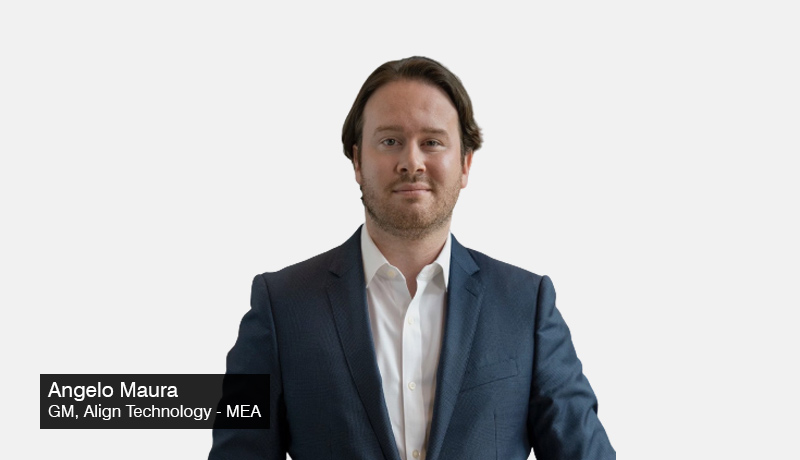
By Angelo Maura, General Manager, Middle East & Africa at Align Technology
The recent pandemic challenged the dental industry to adapt and pivot at unprecedented speed as providers adjusted to care for patients in a new reality. Of all the healthcare disciplines, dentistry is still one of the most ‘physical or tactile,’ one in which in-person consultations and clinical exams are critical. And with patients unable to visit dental clinics during the lockdowns, practitioners had to find ways to deliver seamless and effective continuation of care, all while working remotely.
But meeting these challenges also helped doctors and patients become comfortable with new technologies and ways of working that can help accelerate the way our industry evolves to meet future needs. Though many markets in the Gulf Cooperation Council (GCC) are now seeing a higher number of in-person dental consultations being recorded than at the start of the pandemic, the lessons learned from the past two years suggest that digital dentistry can not only help support better patient outcomes and provide improved continuity of care for patients in treatment, but it can help dentists and orthodontists improve practice efficiency.
We believe these are concepts worth exploring. Doctor-supervised teledentistry can add value to the industry by enhancing patient monitoring and supervision through more frequent doctor-patient communication, increasing patient convenience, and making practices more efficient by giving doctors a way to discuss problems and provide advice and recommendations to patients from virtually anywhere.
Seizing this opportunity needs concerted action that incorporates the perspectives of every stakeholder involved, including orthodontists, dentists, their staff, and patients. To drive this focused, collaborative approach, we recently established an Advisory Council of dental specialists from across the region to help us gain unbiased, neutral insights on ways digital technology is being used and could be further leveraged to support care and improve dental practice. Align also conducted consumer research in over 1000 respondents in Saudi Arabia and UAE to understand how technology could be used to enhance convenience while still supporting or even deepening the doctor-patient relationship.
One of the key points highlighted by both the Council and consumers was that the flexibility that digital technology provides was key to navigating COVID-19 restrictions and was an unexpected positive innovation and should be a regular part of the approach to patient care forward.
So, while an overwhelming 80 per cent of respondents trust that their dental practitioners are taking all necessary precautions to keep in person treatment safe, nearly as many (78 per cent) have found online communication with their dental consultants to be more convenient. This increased adoption and acceptance by patients of digital communication with their doctors (teledentistry) — with more than three-quarters of respondents stating they are willing to use digital engagement tools — dental practitioners have an opportunity to rethink how they operate and how they can integrate more digital technology and tools into their practices to increase doctor-patient communications and office efficiency while maintaining the highest standards of care.
Align’s Invisalign VirtualCare is a digital tool designed to support remote patient-doctor interaction and enable dental practitioners to monitor Invisalign treatments between in-office visits, by reviewing photos submitted by a patient through the My Invisalign app. While there is no substitute for in person exams and visits at key points in treatment and nothing can replace the personal touch of a dentist or orthodontist, digital tools like Virtual Care can supplement the amount of interaction between doctors and patients between office visits.
In the consumer survey Align conducted, 42 percent of respondents said they had not visited a dentist during the pandemic (March – June 2020)due to COVID-19 restrictions. And even after dental practices reopened after lockdowns, less than half (44%) of the respondents said they had visited a dentist.
Though it’s yet unclear whether this is a permanent change, it only makes good sense for practices to introduce and maintain measures that can provide additional flexibility to meet changing patient expectations and still ensure that the doctor-patient bond stays strong. Align believes that when used responsibly by trained, licensed dental healthcare providers, digital technologies and tools like teledentistry have enormous potential to extend professional care and enhance both patient outcomes and convenience. And the dental experts we consulted in our regional Advisory Council have said they are eager to embrace tools that allow greater flexibility and adaptability, as long as they are used in ways that maintain the highest standards of care for patients.
As we think about the future the key task for dental professionals is to consider how to strategically begin integrating more digital technology into day-to-day patient care to smoothly evolve practice in a good way for patients and dentists and maintain a high standard of patient care.
Digital technologies cannot and should not be used to deprive patients of dental professionals’ invaluable expertise and knowledge. Rather we need to leverage these technologies to supplement and amplify their impact – not just to provide care for existing patients but ultimately to extend their reach to patients whose location or the circumstance makes access to care challenges.
Being able to deliver professional, doctor-led care either in person or through online consultations will allow dentists to continue their work of serving the patients, no matter where they are, seamlessly, safely, and efficiently. This will be the pathway to the evolution of the dental industry.